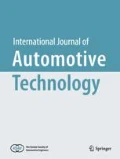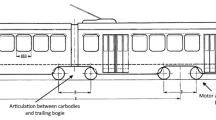Abstract
This paper analyses changes in body geometry and related wheel geometry which may affect the wear of passenger car tyres. By means of an electronic device, changes were measured in the position of the spots that best reflect the changes of the body geometry. This included the front bench attachment, front suspension and rear suspension, at the beginning of the front stringers, at the end of the rear stringers, around the bulkhead, as well as the top mounting points of the McPherson struts. Changes were also identified in geometrical values for the suspension and steering system. The analysed parameters of wheel geometry included, among others, toe-in, inclination angles for all the wheels, camber and castors for front wheels, etc. Tire wear was characterized by the tyre tread size in the inner, middle and outer parts of all four vehicle wheels. Based on the results obtained, quantitative relationships were identified between the mileage of the vehicle, changes in the body geometry, changes in the suspension and steering system geometry, tyre wear and the coefficient of non-uniformity in tyre wear. It was concluded that changes in car body geometry were strictly correlated with vehicle mileage. These changes, in turn, directly influenced changes in wheel geometry which, apart from influencing vehicle safety, also contribute to excessive tyre wear.
Similar content being viewed by others
References
Aguilar, J. J., Sanz, M., Guillomía, D., Lope, M. and Bueno, I. (2006). Analysis, characterization and accuracy improvement of optical coordinate measurement systems for car body assembly quality control. The Int. J. Advanced Manufacturing Technology 30,11–12, 1174–1190.
Andersson, A. (2005). Numerical and experimental evaluation of springback in a front side member. J. Materials Processing Technology 169,3, 352–356.
Brüggemann, C., Horst, P. and Eilert, U. (2007). Verstärkung Geschlossener Profile zur Verbesserung der Crash Eigenschaften von Karosseriestrukturen.
Chen, H., Gong, X., Hu, Y. F., Liu, Q. F., Gao, B. Z. and Guo, H. Y. (2013). Automotive control: the State of the Art and Perspective. Acta Automatica Sinica 39,4, 322–346.
Dionne, G., Michaud, P. C. and Pinquet, J. (2013). A review of recent theoretical and empirical analyses of asymmetric information in road safety and automobile insurance. Research in Transportation Economics 43,1, 85–97.
Duffy, J. E. (2014). Auto Body Repair Technology. Cengage Learning. Boston, MA, USA.
Gonera, J. and Napiórkowski, J. (2018a). Model for forecasting the geometry of the floor panel of a passenger car during its operation. Eksploatacja i Niezawodność 20,4, 689–695.
Gonera, J. and Napiórkowski, J. (2018b). Effect of the mileage of a passenger car on changes in its body geometry. AIP Conf. Proc. 1946,1, 020011.
Gonera, J. and Napiórkowski, J. (2018c). An analysis of the active safety of a passenger car body during car use. MATEC Web of Conf., 182, 01022.
Grote, K. H. and Antonsson, E. K. (Eds.). (2009). Springer handbook of Mechanical Engineering. Springer. Würzburg, Germany.
Habibovic, A. and Davidsson, J. (2012). Causation mechanisms in car-to-vulnerable road user crashes: Implications for active safety systems. Accident Analysis & Prevention, 49, 493–500.
Heißing, B. and Ersoy, M. (2011) Introduction and Fundamentals. In: Heißing B., Ersoy M. (eds). Chassis Handbook. Vieweg +Teubner. Berlin, Germany.
Huang, H., Li, C. and Zeng, Q. (2016). Crash protectiveness to occupant injury and vehicle damage: An investigation on major car brands. Accident Analysis & Prevention, 86, 129–136.
Jahn, A., Heitmanek, M., Standfuss, J., Brenner, B., Wunderlich, G. and Donat, B. (2011). Local laser strengthening of steel sheets for load adapted component design in car body structures. Physics Procedia, 12, 431–441.
Livesey, A. and Robinson, A. (2013). The repair of vehicle bodies. 6th edn. Routledge. New York, USA.
Klasing, J. (2015). Karosserie — reparatur der zukunft: messen & richten. Karosserie Journal der Karosseriebautechniker Österreichs 05.2015.https://issuu.com/9teufel/docs/341008_karosserie_05_15
Klinger, J. F. and Bohn, M. (2013). Predicting dimensional deviations of structural vehicle body parts deep drawn from aluminum blanks. Procedia CIRP, 7, 353–358.
Konieczny, Ł. (2015). Wykorzystanie metod drganiowych w ocenie stanu technicznego mechanicznych i hydropneumatycznych zawieszeń pojazdów samochodowych. Wydawnictwo Politechniki Śląskiej.
Mizuno, D., Suzuki, S., Fujita, S. and Hara, N. (2014). Corrosion monitoring and materials selection for automotive environments by using Atmospheric Corrosion Monitor (ACM) sensor. Corrosion Science, 83, 217–225.
Morello, L., Rossini, L. R., Pia, G. and Tonoli, A. (2011). The Automotive Body: Volume I: Components Design. Springer Science & Business Media. Berlin, Germany.
Niewczas, A. (Ed.). (2005). Wybrane zagadnienia transportu samochodowego: praca zbiorowa. Polskie Naukowo-Techniczne Towarzystwo Eksploatacyjne.
Orsi, C., Marchetti, P., Montomoli, C. and Morandi, A. (2013). Car crashes: The effect of passenger presence and other factors on driver outcome. Safety Science, 57, 35–43.
Przybyłowski, A. (2014). Stan infrastruktury transportu drogowego w Polsce z uwzględnieniem aspektów bezpieczeństwa. Prace Naukowe Uniwersytetu Ekonomicznego we Wrocławiu, 367, 261–271.
Raatz, B. (2005). Nowoczesne technologie pomiarów i napraw karoserii powypadkowych. TROTON.
Schoch, M. (2011). Richtanlagen — Faltenfrei. AUTO SERVICE PRAXIS 02/2011. Springer Fachmedien München GmbH, Germany.
Tobota, A. (1997). Naprawy powypadkowe nadwozi. a bezpieczeństwo. Oficyna Wydawnicza Politechniki Wrocławskiej. Wrocław, Poland.
Wallentowitz, H. (2002). Virtuelle Fahrzeugentwicklung-Netzwerke als Voraussetzungen zur Problemlösung. In Erfolg in Netzwerken, 85–101. Springer, Berlin, Heidelberg, Germany.
Author information
Authors and Affiliations
Corresponding author
Additional information
Publisher’s Note
Springer Nature remains neutral with regard to jurisdictional claims in published maps and institutional affiliations.
Rights and permissions
About this article
Cite this article
Gonera, J., Napiórkowski, J. Analysis of Car Body and Wheel Geometry Depending on Mileage on the Wear of Tyres in Passenger Cars. Int.J Automot. Technol. 22, 253–261 (2021). https://doi.org/10.1007/s12239-021-0025-3
Received:
Revised:
Accepted:
Published:
Issue Date:
DOI: https://doi.org/10.1007/s12239-021-0025-3




